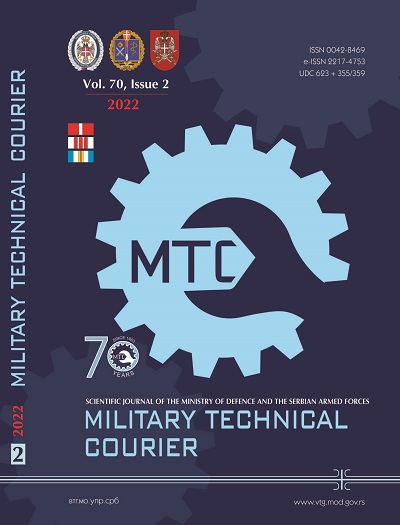An efficient approach for calculating a definite integral with about a dozen of sampling points
Abstract
Introduction/purpose: An approximate approach to definite integral calculation has been an attractive problem continuously since the creation of integration due to practical needs in scientific and engineering areas. In most practical cases, the integrand is complex, which leads to a difficulty of obtaining an exact value of integration, so an approximate value of the definite integral with certain accuracy is satisfactory for practical applications. In this paper, an efficient approach for calculating a definite integral with a small number of sampling points is proposed based on the uniform design method from the viewpoint of practical application.
Methods: The distribution of sampling points in its single peak domain is deterministic and uniform, which follows the rule of the uniform design method and good lattice points.
Results: The efficient evaluation of a definite integral for a periodical function in its single peak domain can be obtained by using 11 sampling points in one dimension, 17 sampling points in two dimensions, and 19 sampling points in three dimensions.
Conclusion: The efficient approach for a definite integral developed here on the basis of the uniform test design method is promised from the viewpoint of practical application; the sampling points are deterministically and uniformly distributed according to the rule of the uniform design method and “good lattice points”. The efficient approach developed in this article will be beneficial to relevant research and application.
References
Byrd, P.F. & Friedman, M.D. 1971. Hand Book of Elliptic Integrals for Engineers and Scientists, 2nd Ed. Berlin, Heidelberg: Springer-Verlag. Available at: https://doi.org/10.1007/978-3-642-65138-0
Caflisch, R.E., Morokoff, W. & Owen, A. 1997. Valuation of mortgage-backed securities using Brownian bridges to reduce effective dimension. Journal of Computational Finance, 1(1), pp.27-46. Available at: https://doi.org/10.21314/JCF.1997.005
Chen, Z., Zheng, X., Luo, C., Zhang, Y. & Chen, X. 2010. Integration of Multivariate Functions by Orthogonal Arrays. Journal of Shanghai Institute of Technology (Natural Science), 2, pp.119-123 [online]. In Chinese. Available at: http://caod.oriprobe.com/articles/25690087/Integration_of_Multivariate_Functions_by_Orthogonal_Arrays.htm [Accessed: 20 January 2022].
Fang, K-T., Liu, M-Q., Qin, H. & Zhou, Y-D. 2018. Theory and Application of Uniform Experimental Designs. Beijing: Science Press & Singapore: Springer Nature. Available at: https://doi.org/10.1007/978-981-13-2041-5
Fang, K-T. & Wang, Y. 1994. Number-theoretic Methods in Statistics. London, UK: Chapman & Hall. ISBN: 0-412-46520-5.
Hua, L-K. & Wang, Y. 1981. Applications of Number Theory to Numerical Analysis. Berlin; New York: Springer-Verlag & Beijing: Science Press. ISBN: 9783540103820.
Ju, S., Yang, X. & Liu, G. 2005. Application of elliptic integral calculus in computing magnetic induction intensity. Journal of Changchun Institute of Technology (Natural Science Edition), 6, pp.70-72 [online]. Available at: https://kns.cnki.net/kcms/detail/detail.aspx? dbcode=CJFD&dbname=CJFD2005&filename=CGCZ200504024&uniplatform=NZKPT&v=ryxpXwQqLAxChu6YS1miYma1Skh6baZ6482KF04E5VURFrx0iFF1b9u19uS2b7G2 (in Chinese) [Accessed: 15 January 2022].
Leobacher, G. & Pillichshammer, F. 2014. Introduction to Quasi-Monte Carlo Integration and Applications. Springer International Publishing Switzerland. Available at: https://doi.org/10.1007/978-3-319-03425-6
Navidi, W. 2020. Statistics for Engineers and Scientists, 5th edition. New York: McGraw-Hill Education. ISBN: 9781260431025.
Paskov, S.H. 1996. New methodologies for valuing derivatives. In: Pliska, S. & Dempster, M. & (Eds.) Mathematics of Derivative Securities, pp.545-582. Cambridge: Isaac Newton Institute & Cambridge University Press. Available at: https://doi.org/10.7916/D8TB1FRJ
Paskov, S.H. & Traub, J.F. 1995. Faster valuation of financial derivatives. Journal of Portfolio Management 22(1), pp.113-120. Available at: https://doi.org/10.3905/jpm.1995.409541
Ripley, B.D. 1981. Spatial Statistics. Hoboken, NJ: John Wiley & Sons. ISBN: 0-47169116-X.
Sloan, I.H. & Woiniakowski, H. 1998. When Are Quasi-Monte Carlo Algorithms Efficient for High Dimensional Integrals?. Journal of Complexity, 14(1), pp.1-33. Available at: https://doi.org/10.1006/jcom.1997.0463
Song, S. & Chen, S. 2004. Two Effective Quadrature Schemes for Calculating Double Integration. Journal of Zhengzhou University, 36, pp.16-19 [online]. Available at: https://kns.cnki.net/kcms/detail/detail.aspx?dbcode= CJFD&dbnam e=CJFD2004&filename=ZZDZ200401003&uniplatform=NZKPT & v=kCi42ClkKjv8yV3dacrXPRtdvn0JHnYAx3nBIo6p2qVlawH9fBMWaaiKoulEFMmf (in Chinese) [Accessed: 15 January 2022].
Tezuka, S. 1998. Financial applications of Monte Carlo and Quasi-Monte Carlo methods. In: Hellekalek, P. & Larcher, G.(Eds.) Random and Quasi-Random Point Sets. Lecture Notes in Statistics, 138, pp.303-332, New York: Springer. Available at: https://doi.org/10.1007/978-1-4612-1702-2_7
Tezuka, S. 2002. Quasi-Monte Carlo - Discrepancy between theory and practice. In: Fang, K.T., Niederreiter, H. & Hickernell, F.J. (Eds.) Monte Carlo and Quasi-Monte Carlo Methods 2000, pp.124-140. Heidelberg: Springer-Verlag. Available at: https://doi.org/10.1007/978-3-642-56046-0_8
Proposed Creative Commons Copyright Notices
Proposed Policy for Military Technical Courier (Journals That Offer Open Access)
Authors who publish with this journal agree to the following terms:
Authors retain copyright and grant the journal right of first publication with the work simultaneously licensed under a Creative Commons Attribution License that allows others to share the work with an acknowledgement of the work's authorship and initial publication in this journal.
- Authors are able to enter into separate, additional contractual arrangements for the non-exclusive distribution of the journal's published version of the work (e.g., post it to an institutional repository or publish it in a book), with an acknowledgement of its initial publication in this journal.
- Authors are permitted and encouraged to post their work online (e.g., in institutional repositories or on their website) prior to and during the submission process, as it can lead to productive exchanges, as well as earlier and greater citation of published work (See The Effect of Open Access).

